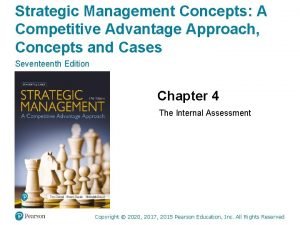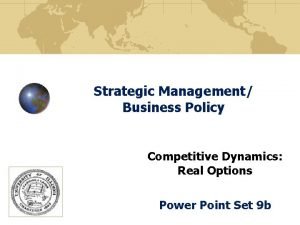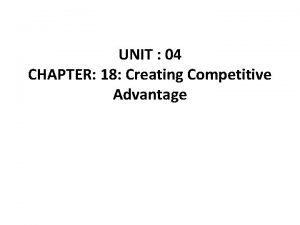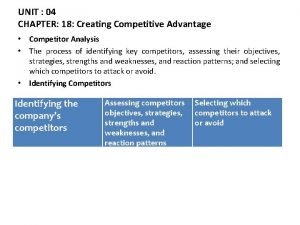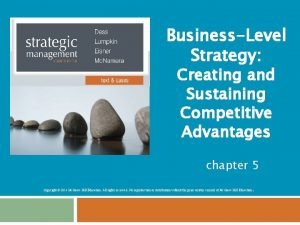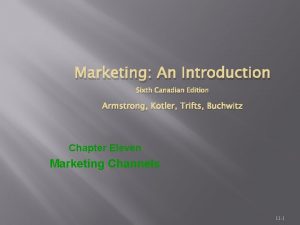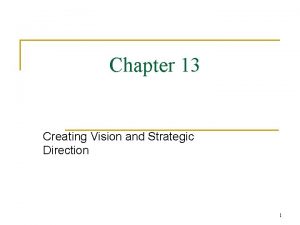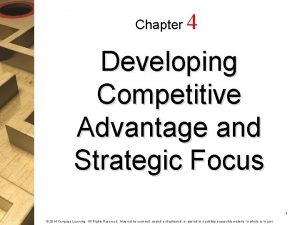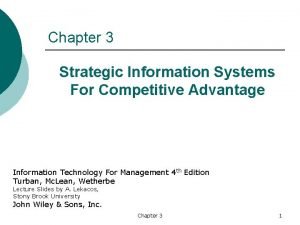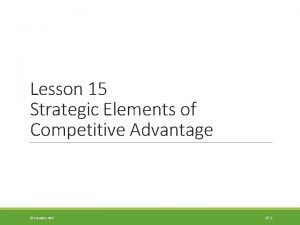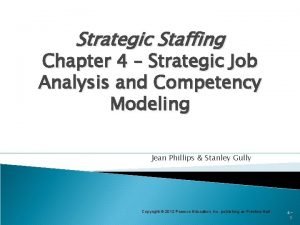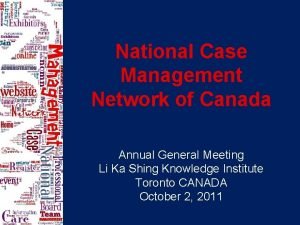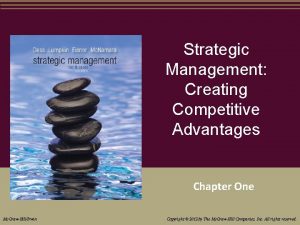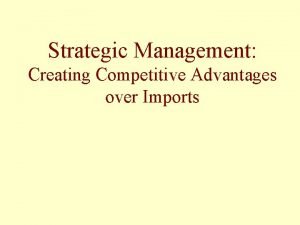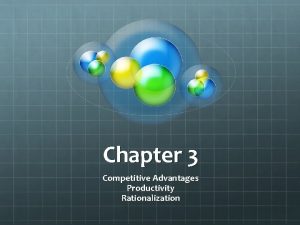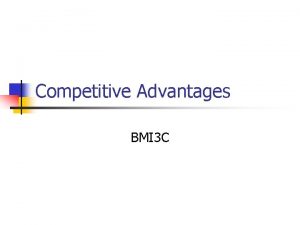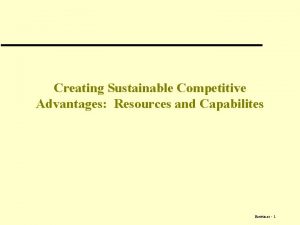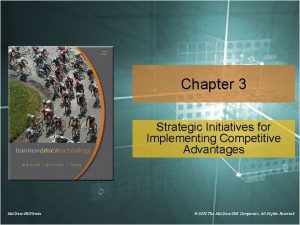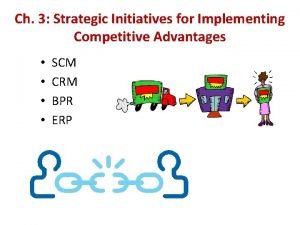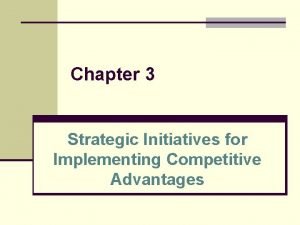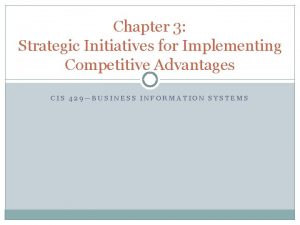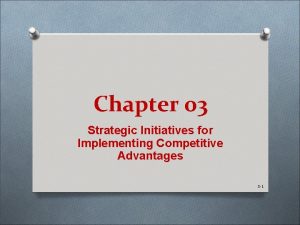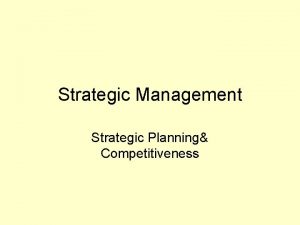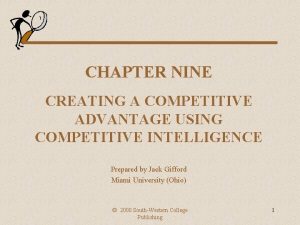Strategic Management Canadian Edition Creating Competitive Advantages Gregory



































- Slides: 35

Strategic Management: Canadian Edition Creating Competitive Advantages Gregory G. Dess G. T. Lumpkin Theodore Peridis Part 1: Strategic Analysis Chapter 2 Analyzing the External Environment of the Firm STRATEGIC MANAGEMENT Mc. Graw-Hill/Irwin Copyright © 2005 by The Mc. Graw-Hill Companies, Inc. All rights reserved.

Learning Objectives • After reading this chapter, you should have a good understanding of: 1. The elements that constitute a firm’s general environment and their impact on the firm’s strategies and performance. 2. How to define the competitive environment and delineate industry boundaries. 3. Why environmental scanning, environmental monitoring, and collecting competitive intelligence are critical inputs to developing forecasts of the business environment. Copyright © 2006 by The Mc. Graw-Hill Companies, Inc. All rights reserved. 2 -2

Learning Objectives • After reading this chapter, you should have a good understanding of: 4. Why scenario planning is a useful technique for firms competing in industries characterized by unpredictability and change. 5. How trends and event in the general environment and forces in the competitive environment are interrelated and affect performance. Copyright © 2006 by The Mc. Graw-Hill Companies, Inc. All rights reserved. 2 -3

Learning Objectives • After reading this chapter, you should have a good understanding of: 6. How forces in the competitive environment can affect profitability and how a firm can improve its competitive position by increasing its power vis-à-vis these forces. 7. The concept of strategic groups and their strategy and performance implications. Copyright © 2006 by The Mc. Graw-Hill Companies, Inc. All rights reserved. 2 -4

Creating the Environmentally Aware Organization Adapted from Exhibit 2. 1 Inputs to Forecasting Copyright © 2006 by The Mc. Graw-Hill Companies, Inc. All rights reserved. 2 -5

Environmental Scanning Surveillance of a firm’s external environment • Predict environmental changes to come • Detect changes already under way • Proactive mode Copyright © 2006 by The Mc. Graw-Hill Companies, Inc. All rights reserved. 2 -6

Environmental Monitoring Track evolution of • Environmental trends • Sequences of events • Streams of activities Copyright © 2006 by The Mc. Graw-Hill Companies, Inc. All rights reserved. 2 -7

Competitive Intelligence • Define and understand a firm’s industry • Identify rivals’ strengths and weaknesses • Intelligence gathering (data) • Interpretation of intelligence data • Helps a firm avoid surprises Copyright © 2006 by The Mc. Graw-Hill Companies, Inc. All rights reserved. 2 -8

What Competitive Intelligence Is and Is Not Competitive Intelligence Is … Competitive Intelligence Is Not … 1. Information that has been analyzed to the point where you can make a decision. 1. Spying implies illegal or unethical activities. It is a rare activity. 2. A tool to alert management to early recognition of both threats and opportunities. 2. A crystal ball. CI is good approximation of reality, it does not predict the future. 3. A means to deliver reasonable assessments. 3. Database search. Data by itself is not good intelligence. 4. A way of life, a process. 4. A job for one smart person. Adapted from Exhibit 2. 2 What Competitive Intelligence (CI) Is and Is Not Copyright © 2006 by The Mc. Graw-Hill Companies, Inc. All rights reserved. 2 -9

Environmental Forecasting • Plausible projections about • Direction of environmental change • Scope of environmental change • Speed of environmental change • Intensity of environmental change Copyright © 2006 by The Mc. Graw-Hill Companies, Inc. All rights reserved. 2 -10

Scenario Analysis • Coping with unpredictability and uncertainty • Considering the possible impact of major shifts in social, technological, demographic, and political trends on the broad environment and the redrawing of the industry • Changes in the “rules of the game” Copyright © 2006 by The Mc. Graw-Hill Companies, Inc. All rights reserved. 2 -11

SWOT Analysis • Managers need to analyze • The general environment • The firm’s industry and competitive environment • SWOT analysis • Strengths • Weaknesses • Opportunities • Threats Basic technique for analyzing firm and industry conditions Copyright © 2006 by The Mc. Graw-Hill Companies, Inc. All rights reserved. 2 -12

The General Environment General Environmen t Demographic Sociocultural Political/Legal Technological Economic Global • General environmental trends and events • Little ability to predict them • Even less ability to control them • Can vary across industries Copyright © 2006 by The Mc. Graw-Hill Companies, Inc. All rights reserved. 2 -13

Demographic Segment • Aging population General Environmen t • Rising affluence • Changes in ethnic composition • Geographic distribution of population Demographic Sociocultural Political/Legal Technological Economic Global • Disparities in income levels Copyright © 2006 by The Mc. Graw-Hill Companies, Inc. All rights reserved. 2 -14

Sociocultural Segment • More women in the workforce General Environmen t • Increase in temporary workers • Greater concern for fitness • Greater concern for environment Demographic Sociocultural Political/Legal Technological Economic Global • Postponement of family formation Copyright © 2006 by The Mc. Graw-Hill Companies, Inc. All rights reserved. 2 -15

Political/Legal Segment • Protection of cultural industries General Environmen t Demographic Sociocultural Political/Legal Technological Economic Global • Aboriginal land claims settlements • Deregulation of utility and other industries • Increases in provincially mandated minimum wages • Taxation at provincial and federal levels • Legislation on corporate governance reforms Copyright © 2006 by The Mc. Graw-Hill Companies, Inc. All rights reserved. 2 -16

Technological Segment • Genetic engineering General Environmen t Demographic Sociocultural Political/Legal Technological Economic Global • Emergence of Internet technology • Computer-aided design/computeraided manufacturing systems (CAD/CAM) • Research in synthetic and exotic materials • Pollution/global warming • Miniaturization of computing technologies • Wireless technology Copyright © 2006 by The Mc. Graw-Hill Companies, Inc. All rights reserved. 2 -17

Economic Segment • Interest rates General Environmen t • Unemployment • Consumer Price index • Trends in GDP Demographic Sociocultural Political/Legal Technological Economic Global • Changes in stock market valuations Copyright © 2006 by The Mc. Graw-Hill Companies, Inc. All rights reserved. 2 -18

Global Segment • Increasing global trade General Environmen t Demographic Sociocultural Political/Legal Technological Economic Global • Currency exchange rates • Emergence of the Indian and Chinese economies • Trade agreements among regional blocs (NAFTA, EU, ASEAN) • Creation of WTO (decreasing tariffs/free trade in services) Copyright © 2006 by The Mc. Graw-Hill Companies, Inc. All rights reserved. 2 -19

The Competitive Environment Competitive Environmen t Competitors Customers Suppliers • Sometimes called the task or industry environment • Includes • Competitors (existing and potential) • Customers • Suppliers • Porter’s five-forces model Copyright © 2006 by The Mc. Graw-Hill Companies, Inc. All rights reserved. 2 -20

Porter’s Five Forces Model of Industry Competition Threat of new entrants Bargaining power of suppliers Bargaining power of buyers Threat of Substitute products and services Adapted from Exhibit 2. 5 Porter’s Five Forces Model of Industry Competition Copyright © 2006 by The Mc. Graw-Hill Companies, Inc. All rights reserved. 2 -21

The Threat of New Entrants • Profits of established firms in the industry may be eroded by new competitors • High entry barriers lead to low of new entries threat • Economies of scale • Product differentiation • Capital requirements • Switching costs • Access to distribution channels • Cost disadvantages independent of scale Copyright © 2006 by The Mc. Graw-Hill Companies, Inc. All rights reserved. 2 -22

The Bargaining Power of Buyers • Buyers threaten an industry • Force down prices • Bargain for higher quality or more services • Play competitors against each other Copyright © 2006 by The Mc. Graw-Hill Companies, Inc. All rights reserved. 2 -23

The Bargaining Power of Buyers • A buyer group is powerful when • It is concentrated or purchases volumes relative to seller sales large • The products it purchases from the industry are standard or undifferentiated • The buyer faces few switching costs • It earns low profits • The buyers pose a credible threat of backward integration • The industry’s product is unimportant to the quality of the buyer’s products or services Copyright © 2006 by The Mc. Graw-Hill Companies, Inc. All rights reserved. 2 -24

The Bargaining Power of Suppliers • Suppliers can exert power by threatening to raise prices or reduce the quality of purchased goods and services Copyright © 2006 by The Mc. Graw-Hill Companies, Inc. All rights reserved. 2 -25

The Bargaining Power of Suppliers • A supplier group will be powerful when • The supplier group is dominated by a few companies and is more concentrated than the industry it sells to • The supplier group is not obliged to contend with substitute products for sale to the industry • The industry is not an important customer of the supplier group Copyright © 2006 by The Mc. Graw-Hill Companies, Inc. All rights reserved. 2 -26

The Bargaining Power of Suppliers • A supplier group will be powerful when • The supplier’s product is an important input to the buyer’s business • The supplier group’s products are differentiated or it has built up switching costs for the buyer • The supplier group poses a credible threat of forward integration Copyright © 2006 by The Mc. Graw-Hill Companies, Inc. All rights reserved. 2 -27

The Threat of Substitute Products and Services • Substitutes limit the potential returns of an industry • Ceiling on the prices that firms in that industry can profitably charge • Price/performance ratio Copyright © 2006 by The Mc. Graw-Hill Companies, Inc. All rights reserved. 2 -28

The Intensity of Rivalry among Competitors in an Industry • Jockeying for position • Price competition • Advertising battles • Product introductions • Increased customer service or warranties Copyright © 2006 by The Mc. Graw-Hill Companies, Inc. All rights reserved. 2 -29

The Intensity of Rivalry among Competitors in an Industry • Interacting factors lead to intense rivalry • Numerous or equally balanced competitors • Slow industry growth • High fixed or storage costs • Lack of differentiation or switching costs • Capacity augmented in large increments • High exit barriers Copyright © 2006 by The Mc. Graw-Hill Companies, Inc. All rights reserved. 2 -30

Using Industry Analyses: A Few Caveats • Five-forces analysis implicitly assumes a zero-sum game • Five-forces analysis could be viewed as only a static analysis • The Value Net Suppliers and customers (the vertical net) n Substitutes and complements (the horizontal net) n Copyright © 2006 by The Mc. Graw-Hill Companies, Inc. All rights reserved. 2 -31

The Value Net Transactions Interactions Transactions Adapted from Exhibit 2. 7 The Value Net Copyright © 2006 by The Mc. Graw-Hill Companies, Inc. All rights reserved. 2 -32

Strategic Groups within Industries • Two unassailable assumptions in industry analysis • No two firms are totally different • No two firms are exactly the same • Strategic groups • Cluster of firms that share similar strategies n n Breadth of product and geographic scope Price/quality Degree of vertical integration Type of distribution system Copyright © 2006 by The Mc. Graw-Hill Companies, Inc. All rights reserved. 2 -33

Strategic Groups within Industries • Value of strategic groups as an analytical tool • Identify barriers to mobility that protect a group from attacks by other groups • Identify groups whose competitive position may be marginal or tenuous • Chart the future direction of firms’ strategies • Thinking through the implications of each industry trend for the strategic group as a whole Copyright © 2006 by The Mc. Graw-Hill Companies, Inc. All rights reserved. 2 -34

The World Automobile Industry: Strategic Groups Adapted from Exhibit 2. 8 The World Automobile Industry: Strategic Groups Copyright © 2006 by The Mc. Graw-Hill Companies, Inc. All rights reserved. 2 -35
 Strategic management a competitive advantage approach
Strategic management a competitive advantage approach Competitive dynamics in strategic management
Competitive dynamics in strategic management Value creation strategy
Value creation strategy Chapter 18 creating competitive advantage
Chapter 18 creating competitive advantage Porters 3 generic strategy
Porters 3 generic strategy Chapter 18 creating competitive advantage
Chapter 18 creating competitive advantage Chapter 18 creating competitive advantage
Chapter 18 creating competitive advantage The two least common competitive structures are
The two least common competitive structures are Pharmacology introduction
Pharmacology introduction Market commonality and resource similarity examples
Market commonality and resource similarity examples Marketing an introduction 6th canadian edition
Marketing an introduction 6th canadian edition Accounting principles second canadian edition
Accounting principles second canadian edition Accounting principles second canadian edition
Accounting principles second canadian edition Accounting principles second canadian edition
Accounting principles second canadian edition Fundamentals of corporate finance 3rd canadian edition
Fundamentals of corporate finance 3rd canadian edition Accounting principles second canadian edition
Accounting principles second canadian edition Fundamentals of corporate finance canadian edition
Fundamentals of corporate finance canadian edition Resource based model
Resource based model Tows matrix
Tows matrix Vision focuses on the current reality and maintaining it
Vision focuses on the current reality and maintaining it Society of competitive intelligence
Society of competitive intelligence Developing competitive advantage and strategic focus
Developing competitive advantage and strategic focus Strategic planning for competitive advantage
Strategic planning for competitive advantage Chapter 2 strategic planning for competitive advantage
Chapter 2 strategic planning for competitive advantage Strategic information system for competitive advantage
Strategic information system for competitive advantage Strategic planning for competitive advantage
Strategic planning for competitive advantage Strategic planning for competitive advantage
Strategic planning for competitive advantage Elements of competitive advantage
Elements of competitive advantage Using mis (10th edition) 10th edition
Using mis (10th edition) 10th edition Using mis (10th edition)
Using mis (10th edition) Strategic job analysis and competency modeling
Strategic job analysis and competency modeling Canadian emergency management college
Canadian emergency management college Canadian standards of practice for case management
Canadian standards of practice for case management Strategic fit vs strategic intent
Strategic fit vs strategic intent Strategic complements and substitutes
Strategic complements and substitutes Human resource management gaining a competitive advantage
Human resource management gaining a competitive advantage
